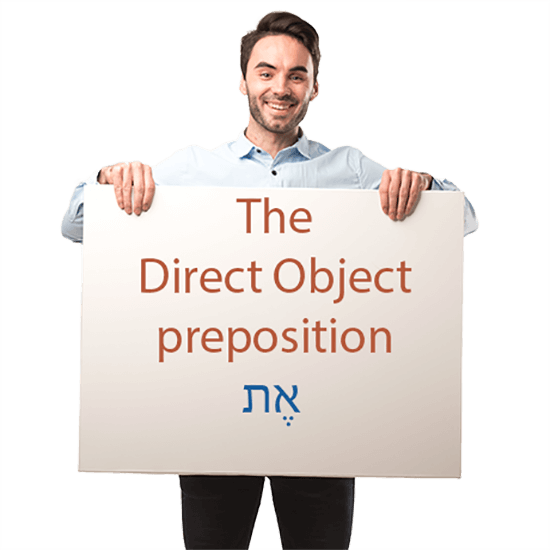Lesson 6 - Do You Know Danny?
Listen to this lesson
The full lesson is available only to Speaking Hebrew: Beginners Course subscribers.
Each of our lessons includes: 3 audio learning sessions, a quiz, and plenty of interactive learning games and reading tutorials.
Try a Free Lesson
Test your level with the audio and video lessons below to decide which of our full courses is best for you!
-or- Sign Up Today
Hebrew Lesson Number 6:
Do You Know Danny?

They say it’s a small world, and when it comes to Israelis it’s especially true! Someone always knows someone. Find out if you know someone too!
Learning Hebrew Online
Our Hebrew Transliteration System
Transliteration is the technique of using a system of letters taken from one language for writing words of another language, which has a different letters’ system.
In our case, we will use letters from the English Alphabet for transcribing words in Hebrew, meaning, words that are originally written in the Hebrew Alef Bet.
Let’s see two examples of words you’re probably familiar with
To-ra
Sha-lom
Transliteration, by its nature, is not a definite technique and one might find different ways of writing the same origin word when transformed into another set of letters.
Described here, you will find our approach for transliteration.
We believe that by reviewing the next “transliteration map” and understanding its basic logic, you will find reading English transliteration of Hebrew words, a very easy task.
One thing needs to be strongly acknowledged before beginning to practice:
Hebrew is a very “syllabetic” language, meaning, each syllable is very well distinguished from its previous or next syllable. When starting to practice,please use this knowledge as your basic reading rule. Start by reading slowly and make sure each Hebrew syllable is separate and distinguished!

Please also note that in Hebrew, there are two kinds of syllables: an open syllable and a closed syllable.
The open syllable ends with a vowel. The closed syllable ends with a consonant.
In the Hebrew word - sha-lom, the first syllable “sha” is an open one. The second syllable “lom” is a closed one.
In the Hebrew word - To-ra, both of the syllables are open.

תורה
There are ONLY five vowels in Hebrew. When actually reading Hebrew, there are several options of writing and reading each of these vowels, but on our transliteration, we will use only one English letter for each vowel articulation.
The letter “a” will always be used as A
The letter “e” will always be used as E
The letter “I” will always be used as I
The letter “o” will always be used as O
The letter “u” will always be used as U
Introduction to Lesson 6:
Do You Know Danny?

Learn Hebrew Pod - Lesson No. 6
Israel is a country steeped in culture and appreciation for the performing arts. It is home to the internationally-acclaimed Israel Philharmonic Orchestra, Ha-bima Theatre, the Israel Opera, the Israel Ballet, and the Akko Theater Festival--just to name a few.
Liat and Eran are very involved in the arts . . . they are both actors, and Liat is a dancer as well! In honor of Liat’s upcoming performance with her dance company, in Learn Hebrew Pod Lesson 6A, we will learn some dance-related vocabulary.

Dance Company - להקת מחול
We’ll also learn the Hebrew way to send someone regards (since it turns out that Eran and Liat have many friends in common within the artistic community).
In addition, we will get our first look at a special Hebrew word that does not exist in English--the word “et.”
Then in Audio/Visual Lesson 6B, we will build on what we learned in Lessons 3 and 4, as Jonathan introduces us to one of the most important and unique features of the Hebrew language--the system of building blocks used to conjugate verbs.

Because 90% of Hebrew verbs are in the first building block we will meet--called pa-al, we can accomplish so much just by learning this one. Magniv - Cool!
Lesson 6 has a little something for everyone--patrons of the arts, grammar aficionados, even Beatles fans!
So listen and learn to speak Hebrew on your way out to see a show . . . or a concert . . . or a ballet. And Liat--Break a leg! Behazzlacha!!

!בהצלחה
Some Hebrew Grammar from This Lesson:
A Unique Hebrew Word -
The Preposition ‘Et’
Eran, your first sentence to Liat was: ”at makira et Danny?” We know that this is the way to ask a question in Hebrew. It will be the same as a statement, but we will articulate or stress it as a question.
The statement is “at makira et Danny” which is “you know Danny” and the question is the same, but again, we put it as a question “at makira et Danny?”
Now, except for that, you are using here another Hebrew word that is not translated literally into English. Let’s review the words in this sentence again.

Eran: “at“ meaning “you“, “makira”- “know“, when addressing a female, “et”….oh…that is a special Hebrew word that does not exist in English. And in my sentence it comes before Danny. “at makira et Danny?” .
Jonathan: Exactly. As In Hebrew we do not use some words that we use in English, such as the “to be” verbs, In English we don’t use some words that we use in Hebrew.
The word “et” is a very important word in Hebrew, but it has no equivalence in English.
In Hebrew, it comes between a verb and an object. But it will be there, only when the object is particular, meaning, when we are talking about some specific known object.
In our sentence, because you are referring to a specific person whose name is Danny you have to put the word “et” between the verb and the person.
Between makira & Danny… “at makira et Danny?”
It can be described as a connecting word between a verb and a particular object it refers to. This is just a taste of the way to use the “et” word.

For now, let’s have some examples of sentences in which we will use the “et” versus some that we will not:
Eran, how would you ask Liat: ”Do you know a dancer?”
Eran: Since, in this instance I’m asking her if she knows a dancer, and this can be any dancer and not someone particular, I will just ask:
“at makira rakdan?”
It might make more sense if I’m looking for a good dancer, and I asked her:
“at makira rakdan tov?”…. “Do you know a good dancer?”

?את מכירה רקדן טוב
Jonathan: And if you’re asking her about someone specific?
Eran: Then, as we learned, before the specific name of this dancer, I will put “et”.
“at makira et Eyal?”, “at makira et Rachel?” etc.

!אני מכירה המון אנשים
*Read the full grammar discussion by using the Learn Hebrew Pod unique Audio/Visual Hebrew learning sessions - Lessons A, B and C at the top of this page.





